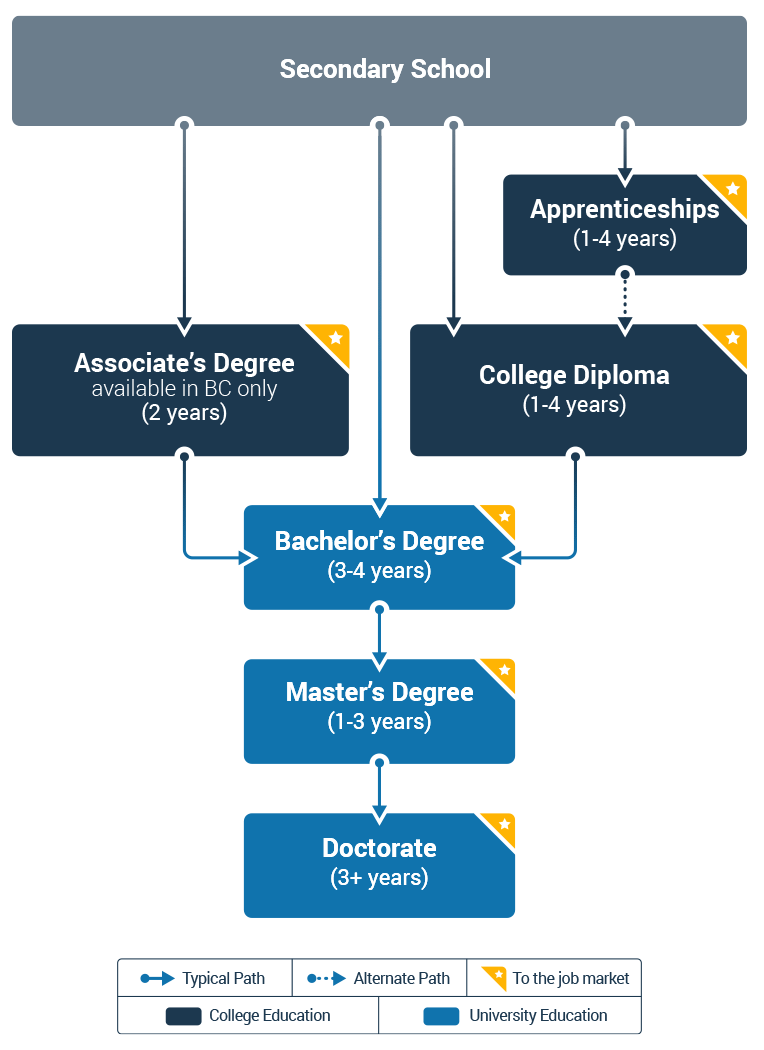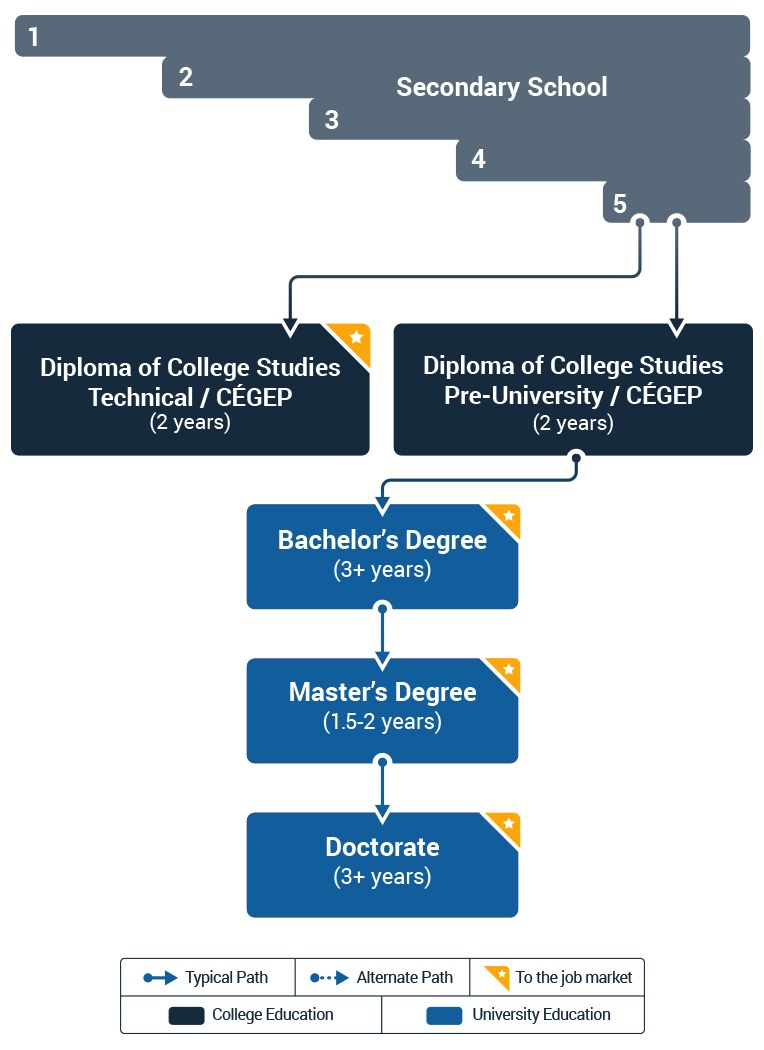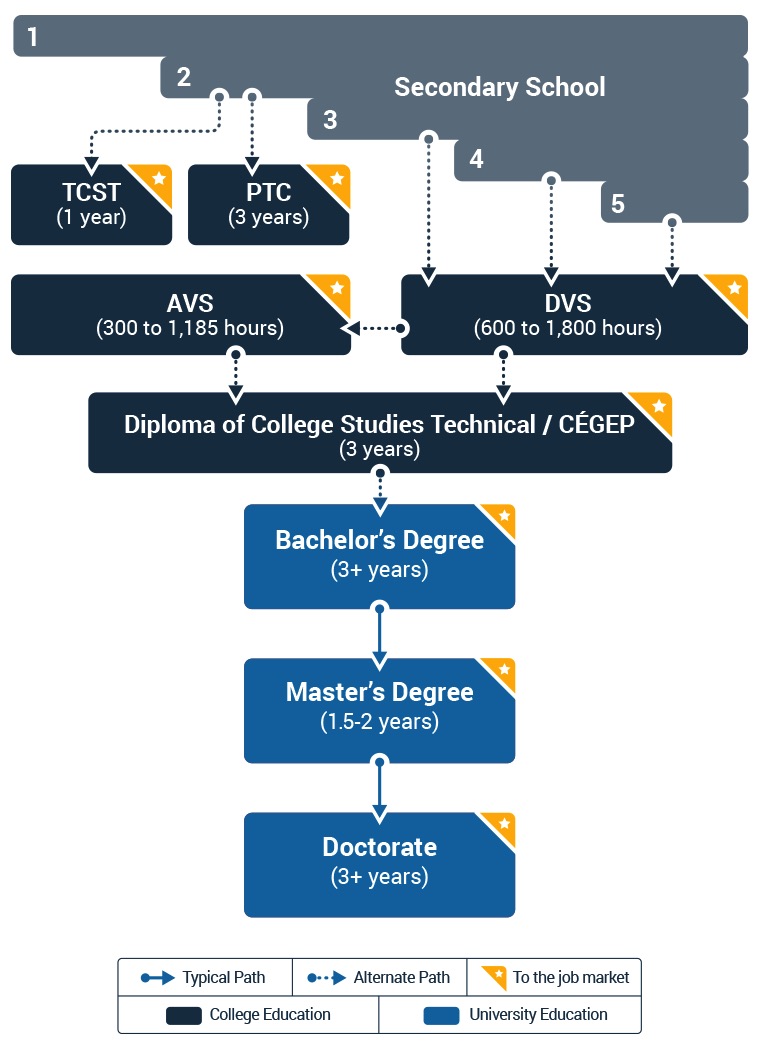
You live and go to school in Canada, so what else is there for you to know about our country’s education system? You may not even think about your education pathways until you’re in your senior year of high school. At this point, you may only be aware of two options: college and university. But, there’s more to Canada’s education system than that. What if you want to get a master’s degree after a college diploma — is that even possible? Explore all your higher education options to find the path meant for you:
Your education pathway in all of Canada, except Quebec
High school in Canada looks the same everywhere you go — except in Quebec. You’ll complete four years of high school — grades nine to twelve — and then select your post-secondary option. Will you go to college or university? Which one will help you enter the workforce quicker? Explore your options for studying in Canada's English-dominant provinces — Alberta, British Columbia, Manitoba, New Brunswick, Newfoundland and Labrador, Northwest Territories, Nova Scotia, Nunavut, Ontario, Prince Edward Island, Saskatchewan, and Yukon:

Everything look familiar so far? You may have a pretty good idea for what your education pathway looks like in your own province, but you might not be aware of what other provinces are doing as well.
Did you know that the Northwest Territories and Nunavut have no colleges and universities? Students in these areas may be able to earn a degree through partnerships or by going to school outside of the territories.
Also, British Columbia offers associate degrees as well! These are two-year undergraduate program that help you transition to the last two years of a bachelor's degree at a university. They’re offered mainly by colleges, but also some universities.
You may also have come across two different types of colleges. What's the difference between a college and a career college? Good question! Career colleges are private post-secondary institutions that provide career-specific programs. Public colleges are funded by the government — meaning cheaper tuition fees! — and offer a larger range of courses.
So, if you’re wanting a straightforward education that is similar across the country, then studying at any of the provinces across Canada — excluding Quebec — could be the best choice for you. You could choose to stay in your own province or venture across the country for a similar education path.
Quebec’s education pathway
Quebec's education system is a bit different than the rest of Canada's. In Quebec, your high school education is from grade seven to eleven, then you'll go on to a college or university education. Check out what a typical pathway for a student in Quebec looks like:

That was the typical education pathway that many students in Quebec may choose, but that’s also not the only option out there! Check out these alternate education pathways for students in Quebec:

Wow! There’s a lot of pathways students in Quebec can choose to take for their education! Let’s unpack this a bit. Instead of grade 12, Quebec students typically go on to college (also known as CÉGEP). This is the Diploma of College Studies Pre-university and the Diploma of College Studies Technical. After completing the Diploma of College Studies Pre-university, they can then apply to university. Once they complete the Diploma of College Studies Technical, they’ll be able to go straight into the job market or continue with their education.
So then what are PTC, AVS, DVS, and TCSTs?
- PTC: a Pre-work Training Certificate is offered to students at the age of 15 who haven't completed their elementary-level studies in the language of instruction and math. It also includes workplace practicums.
- TCST: a Training Certificate in a Semiskilled Trade is offered to students at the age of 15 who have completed their elementary-level studies in the language of instruction and math, but haven't received any credits in these subjects.
- DVS: a Diploma of Vocational Studies indicates a student has completed a secondary-level vocational program for a trade or occupation, such as carpentry or hairdressing.
- AVS: an Attestation of Vocational Specialization is a training program aimed at improving skills or specialization in a trade, such as high-pressure welding or toolmaking.
So, if you’re already in high school in Quebec, then you could stick with what you know and continue your education there. Or, if you’re from outside Quebec and are interested in learning French or pursuing a trade, then this may be a great place for you to study!
Still having a tough time understanding the different education pathways in Canada? Check out this quick video on how Canada's education system works:
The great thing about getting an education in Canada, is that you'll have plenty of opportunities to enter the job market and begin your career. It's up to you (and also what your dream career requires) to decide how much education you want to pursue.
Keep in mind that everyone's education path is different. Some people may start their career after a bachelor's degree and then take a master's degree a few years later. Others might get a trades certification and start working after only a year or two of study. What will your education pathway look like?
Find your dream program